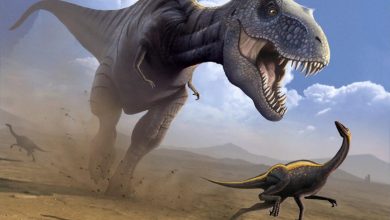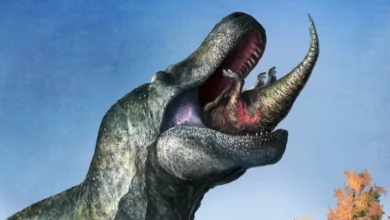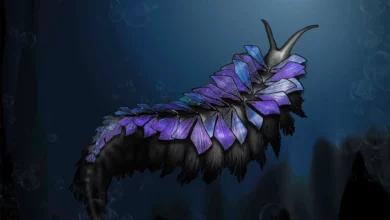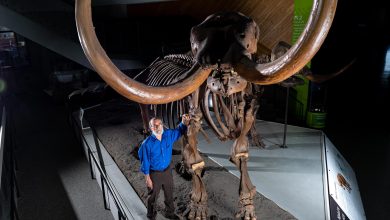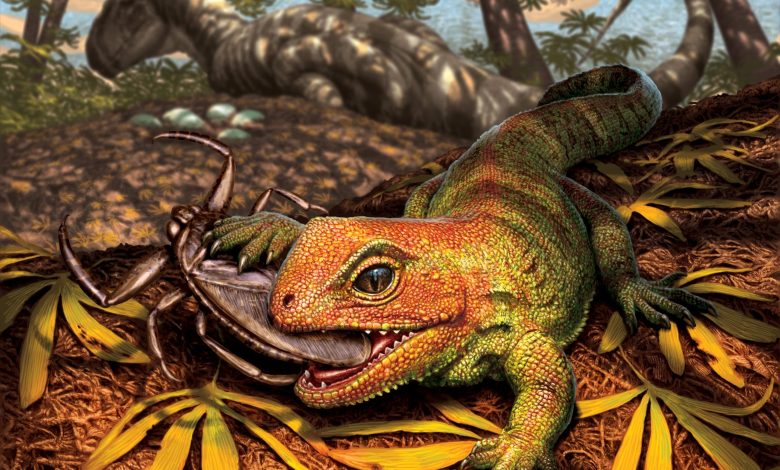
Lead Image: An artistic interpretation of a newly discovered extinct species of lizard-like reptile belonging to the same ancient lineage as New Zealand’s living tuatara. The newly discovered Opisthiamimus gregori preys on a now-extinct water bug (Morrisonnepa jurassica), while in the background the predatory dinosaur Allosaurus jimmadseni guards its nest. The scene is the floodplain of a river in Late Jurassic Wyoming, approximately 150 million years ago. A team of scientists describes the new species, which once inhabited Jurassic North America about 150 million years ago alongside dinosaurs like Stegosaurus and Allosaurus, in a paper published today in the Journal of Systematic Palaeontology. In life, this prehistoric reptile would have been about 16 centimeters (about 6 inches) from nose to tail and would fit curled up in the palm of an adult human hand. The discovery comes from a handful of specimens including an extraordinarily complete and well-preserved fossil skeleton excavated from a site centered around an Allosaurus nest in northern Wyoming’s Morrison Formation. Credit: Julius Csotonyi for the Smithsonian Institution
Discovery sheds light on the tuatara, the last living member of a once-diverse group of reptiles that has almost entirely been supplanted by lizards.
A new extinct species of lizard-like reptile that belongs to the same ancient lineage as New Zealand’s living tuatara has been discovered by Smithsonian researchers. The new species Opisthiamimus gregori, which once inhabited Jurassic North America about 150 million years ago alongside dinosaurs like Stegosaurus and Allosaurus, is described in a paper published on September 15, 2022, in the Journal of Systematic Palaeontology. In life, this prehistoric reptile would have been about 16 centimeters (about 6 inches) from nose to tail—and would fit curled up in the palm of an adult human hand. It likely survived on a diet of insects and other invertebrates.
A team of scientists, including the National Museum of Natural History’s curator of Dinosauria Matthew Carrano and research associate David DeMar Jr. as well as University College London and Natural History Museum, London scientific associate Marc Jones, contributed to the research.
“What’s important about the tuatara is that it represents this enormous evolutionary story that we are lucky enough to catch in what is likely its closing act,” Carrano said. “Even though it looks like a relatively simple lizard, it embodies an entire evolutionary epic going back more than 200 million years.”
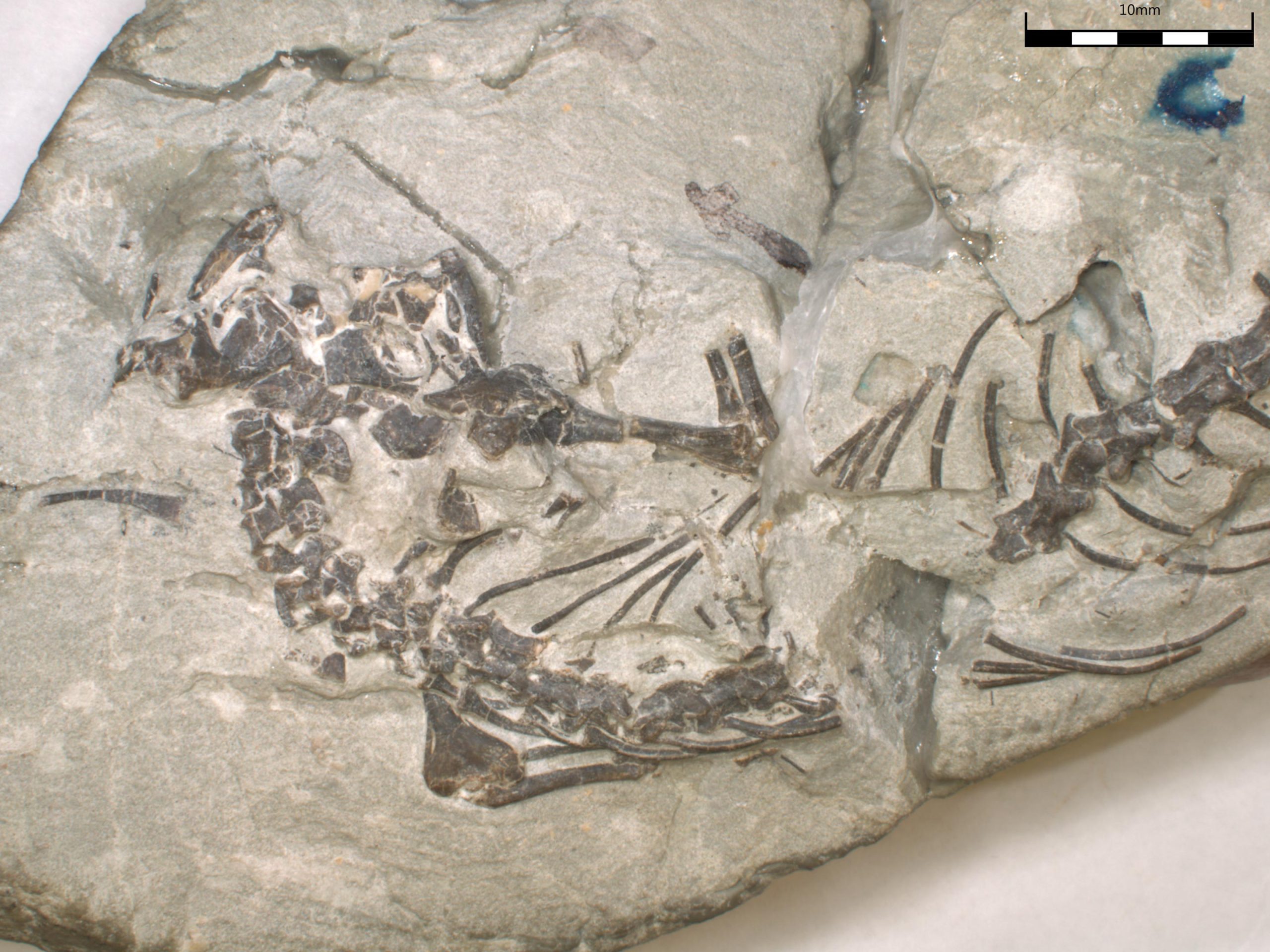
The discovery comes from a handful of specimens, one of which was an incredibly complete and well-preserved fossil skeleton excavated from a site centered around an Allosaurus nest in northern Wyoming’s Morrison Formation. Further investigation of the find could help reveal why this animal’s ancient order of reptiles was winnowed down from being diverse and numerous in the Jurassic to only New Zealand’s tuatara surviving today.
Although the tuatara looks a bit like a particularly stout iguana, the tuatara and its newly discovered relative are in fact not lizards at all. They are actually rhynchocephalians, an order that diverged from lizards at least 230 million years ago, Carrano said.
The research team set about scanning the fossil with high-resolution computed tomography (CT), a method that uses multiple X-ray images from different angles to create a 3D representation of the specimen. The team used three separate CT scanning facilities, including one housed at the Smithsonian’s National Museum of Natural History, to capture everything they possibly could about the fossil. Once the fossil’s bones had been digitally rendered, the team set about reassembling the digitized bones of the skull, some of which were crushed, out of place, or missing on one side, using software to eventually create a nearly complete lifelike 3D reconstruction. A team of scientists describes the new species Opisthiamimus gregori, which once lived alongside dinosaurs like Stegosaurus and Allosaurus, in a paper published today in the Journal of Systematic Palaeontology. In life, this prehistoric reptile would have been about 16 centimeters (about 6 inches) from nose to tail—and would fit curled up in the palm of an adult human hand—and likely survived on a diet of insects and other invertebrates. Credit: D. DeMar
In their heyday during the Jurassic period, rhynchocephalians were found nearly worldwide and came in sizes large and small. They filled ecological roles ranging from aquatic fish hunters to bulky plant munchers. But for reasons that are still not fully understood, rhynchocephalians all but disappeared as lizards and snakes grew to be the more common and more diverse reptiles across the globe.
This evolutionary chasm between lizards and rhynchocephalians helps explain the tuatara’s strange features. These include a 100-year-plus lifespan, teeth fused to the jaw bone, a unique chewing motion that slides the lower jaw back and forth like a saw blade, and a tolerance for colder climates.
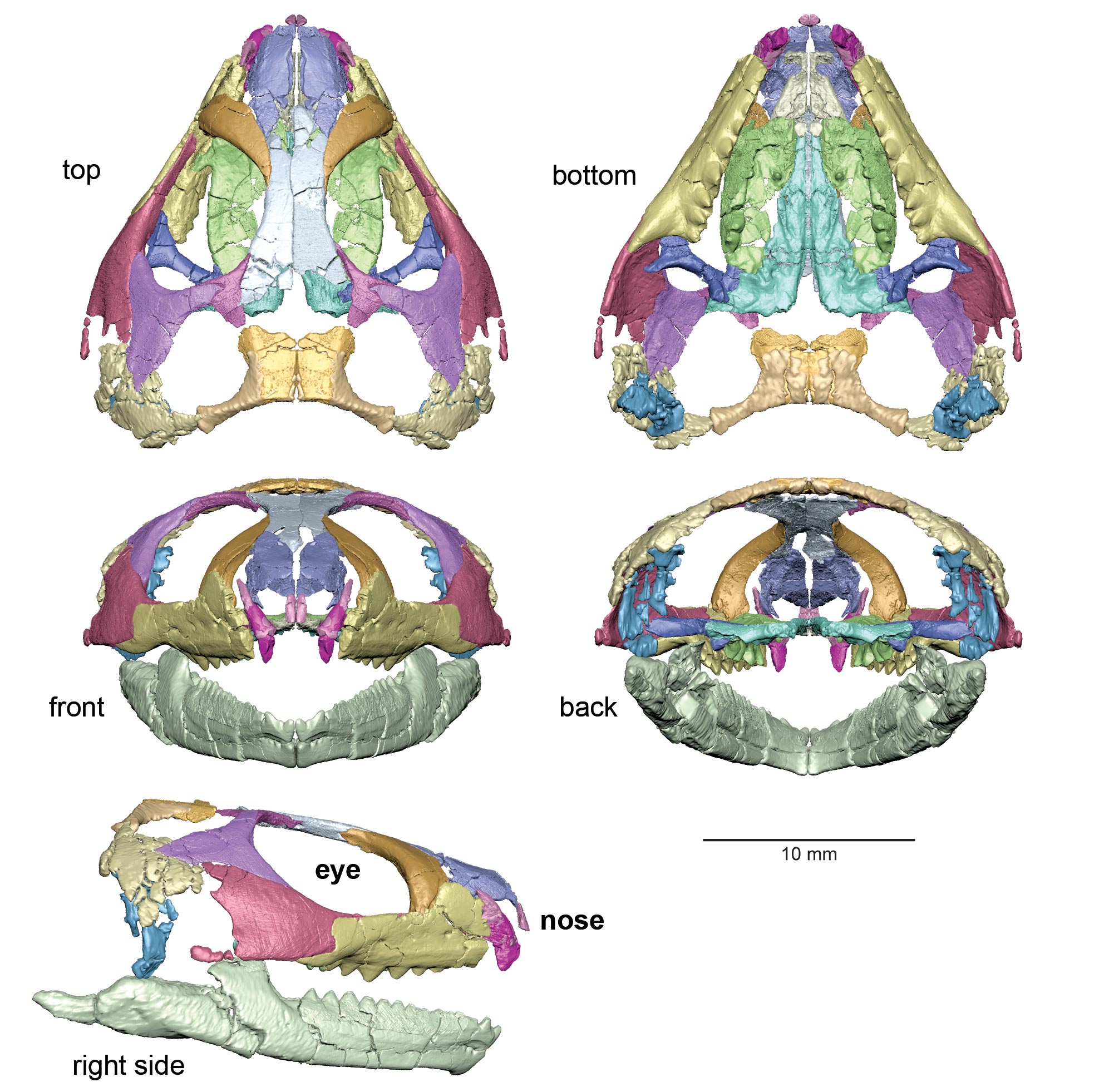
Following O. gregori’s formal description, Carrano said the fossil has been added to the museum’s collections where it will remain available for future study. Perhaps one day it will help scientists figure out why the tuatara is all that remains of the rhynchocephalians, while lizards are now found across the globe.
“These animals may have disappeared partly because of competition from lizards but perhaps also due to global shifts in climate and changing habitats,” Carrano said. “It’s fascinating when you have the dominance of one group giving way to another group over evolutionary time, and we still need more evidence to explain exactly what happened, but fossils like this one are how we will put it together.”
The new species is named after Joseph Gregor, a museum volunteer who spent hundreds of hours painstakingly scraping and chiseling the bones from a block of stone that drew the attention of Pete Kroehler, a museum fossil preparator, back in 2010.
“Pete is one of those people who has a kind of X-ray vision for this sort of thing,” Carrano said. “He noticed two tiny specks of bone on the side of this block and marked it to be brought back with no real idea what was in it. As it turns out, he hit the jackpot.”
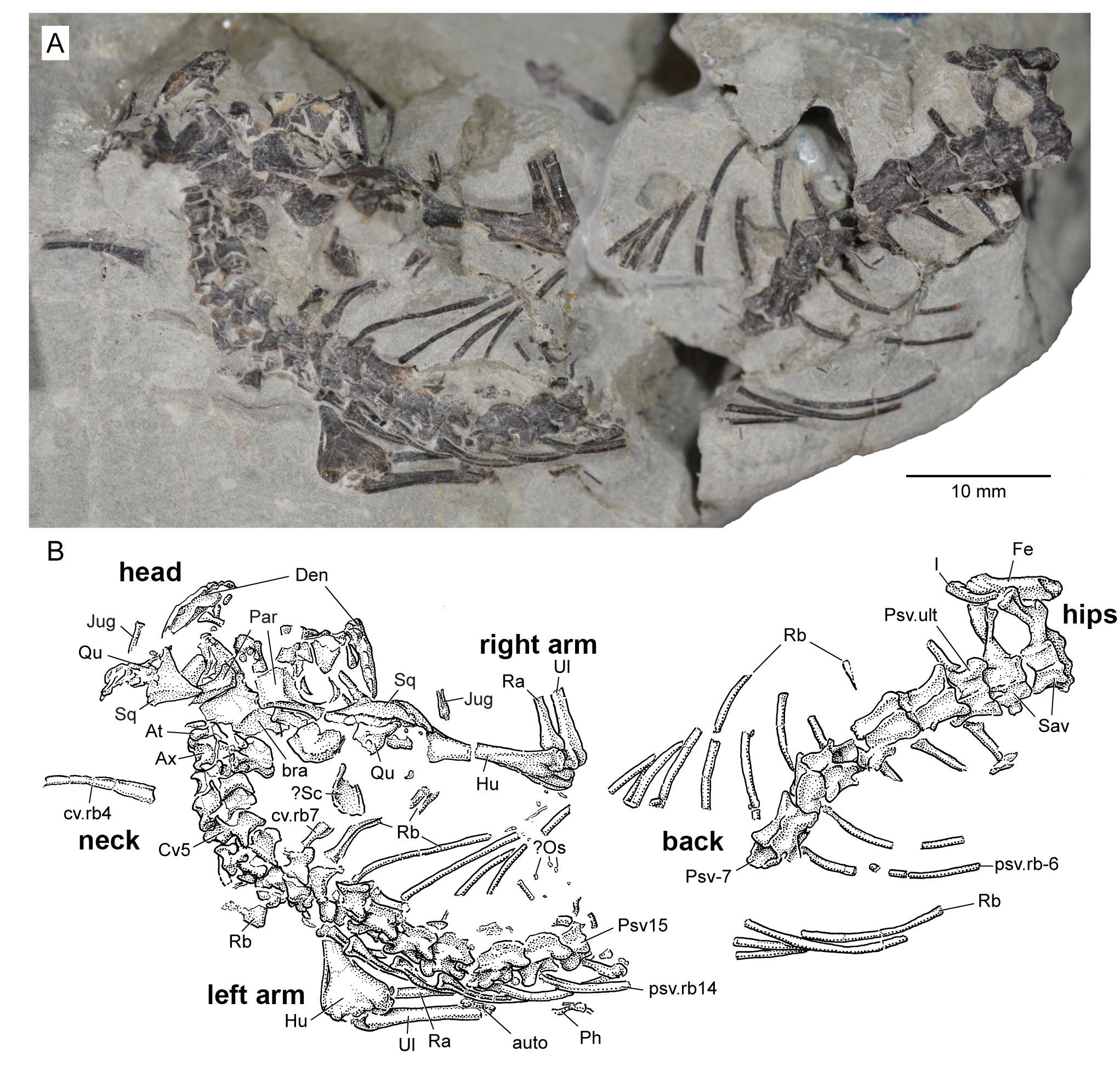
The fossil is almost entirely complete, with the exception of the tail and parts of the hind legs. Such a complete skeleton is rare for small prehistoric creatures like this, Carrano said, because their frail bones were often destroyed either before they fossilized or as they emerge from an eroding rock formation in the present day. As a result, rhynchocephalians are mostly known to paleontologists from small fragments of their jaws and teeth.
After Kroehler, Gregor and others had freed as much of the tiny fossil from the rock as was practical given its fragility, the team, led by DeMar, set about scanning the fossil with high-resolution computerized tomography (CT). This is a method that uses multiple X-ray images from different angles to create a 3D representation of the specimen. The research team used three separate CT scanning facilities, including one housed at the National Museum of Natural History, to capture everything about the fossil they possibly could.
Once the fossil’s bones had been digitally rendered with an accuracy smaller than a millimeter, DeMar set about reassembling the digitized bones of the skull. Some of them were crushed, out of place, or missing on one side, so software was used to eventually create a nearly complete 3D reconstruction. This reconstructed 3D skull now provides scientists with an unprecedented look at this Jurassic-age reptile’s head.
Given Opisthiamimus’s diminutive size, tooth shape, and rigid skull, it likely ate insects, said DeMar, adding that prey with harder shells such as beetles or water bugs might have also been on the menu. Broadly speaking, the new species looks quite a bit like a miniaturized version of its only surviving relative (tuataras are about five times longer).
“Such a complete specimen has huge potential for making comparisons with fossils collected in the future and for identifying or reclassifying specimens already sitting in a museum drawer somewhere,” DeMar said. “With the 3D models we have, at some point, we could also do studies that use software to look at this critter’s jaw mechanics.”
Reference: “A nearly complete skeleton of a new eusphenodontian from the Upper Jurassic Morrison Formation, Wyoming, USA, provides insight into the evolution and diversity of Rhynchocephalia (Reptilia: Lepidosauria)” 15 September 2022, Journal of Systematic Palaeontology.
DOI: 10.1080/14772019.2022.2093139
Funding and support for this research were provided by the Smithsonian and the Australian Research Council.

